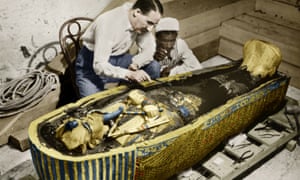Egyptologist Howard Carter dies - archive, 1939
3 March 1939: The archeologist discovered the tomb of the Egyptian pharaoh Tutankhamun
Mon 5 Mar 2018 13.26 EST

Howard Carter with the sarcophagus of Tutankhamun, around 1925. Photograph: ullstein bild via Getty Images
Mr. Howard Carter, the Egyptologist, was born at Swaffham, in Norfolk, in 1873. Because of his poor health when a boy he was educated privately. When seventeen years of age he obtained a post as draughtsman on the staff of the Egypt Exploration Fund, which had in the previous year established an Archeological Survey, the purpose of which was to make records of the monuments above ground and exposed to pillage and destruction.
He went in 1890 with Flinders Petrie to excavate with him in a wonderful season of discovery at Tel-el-Amarna. In May, 1893, he was again with the survey, but went on to Deir el-Bahari to assist Professor Naville in the work of the Egypt Exploration Fund on the great temple of Hatshepsut, and was busily employed there until 1899.
In 1900 Carter became Inspector of Antiquities in Upper Egypt for the Egyptian Government, but although he held this and similar posts under the Government for five years and did much good work he was not either by training or by temperament a person to endure patiently the demands for reports for the Government and the worries of official life.
In 1907 Lord Carnarvon engaged Carter to help him in the formation of his fine collection of Egyptian antiquities at Highclare, and further in the search for more royalties in the Theban necropolis. After 1911 his work was more widely spread, but barren of striking finds, though interesting to the historian and the specialist.
Burial site of Egypt's boy-king Tutankhamun discovered
Read more
In 1914, however, permission was obtained for excavations in the Valley of the Tombs of the Kings, abandoned as exhausted by Theodore Davis. After several seasons' work from 1917 onwards with small success, the patch of ground which Carter had marked out as the most promising of all, though extremely difficult to work, was made to reveal in 1923 the entrance of an unknown tomb. When it was opened in the presence of Lord Carnarvon it was at once recognised as by far the most wonderful discovery of ancient tomb furnishings on record. It had been partly robbed in antiquity and again sealed up.
Carefully to empty one chamber of its half-plundered and fragile furnishings took Carter a whole season, in which he had the help of a large staff of assistants. The sarcophagus chamber was intact and the triple catafalque with its appurtenances took another season to dismantle and remove, a triumph of ingenuity and patience in the narrow cell. To empty the golden sarcophagus of its treasures, fixed in a flood of resin, occupied the season 1925-6, and still the unplundered annex of this chamber and a plundered chamber behind the first remained to be done. Such was the tomb of the boy-king Tutankhamun, whose name, with that of his discoverer, is now a household word.
The British archeologist Howard Carter and an Egyptian assistant examine the sarcophagus containing the body of the pharaoh Tutankhamun in the Valley of the Kings, Egypt.

The British archeologist Howard Carter and an Egyptian assistant examine the sarcophagus containing the body of the pharaoh Tutankhamun in the Valley of the Kings, Egypt. Photograph: Apic/Getty Images
The enormous store of golden, jewelled and other treasures discovered in the tomb, although really priceless, were estimated commercially as being worth over £2.000.000.The Egyptian Government took possession of the treasures without regard to the large sums spent by the late Lord Carnavon in finding them, but in April 1930 made a grant of £35.000 to his heirs.
A man of great practical capacity and independence, Carter could engineer anything with his own hands and dominate his workmen, enforcing his orders with a perfectly adequate command of spoken Arabic from an early stage of his career. His knowledge of animals and of wild life generally was remarkable. His pencil and brush have illustrated a large number of important archeological publications, often accounts of his own discoveries written by himself.
Since you're here …
… we have a small favour to ask. More people are reading the Guardian than ever but advertising revenues across the media are falling fast. And unlike many news organisations, we haven't put up a paywall – we want to keep our journalism as open as we can. So you can see why we need to ask for your help. The Guardian's independent, investigative journalism takes a lot of time, money and hard work to produce. But we do it because we believe our perspective matters – because it might well be your perspective, too.
I appreciate there not being a paywall: it is more democratic for the media to be available for all and not a commodity to be purchased by a few. I'm happy to make a contribution so others with less means still have access to information. Thomasine F-R.
If everyone who reads our reporting, who likes it, helps fund it, our future would be much more secure. For as little as $1, you can support the Guardian – and it only takes a minute. Thank you.
Sent from my Linux system.
No comments:
Post a Comment